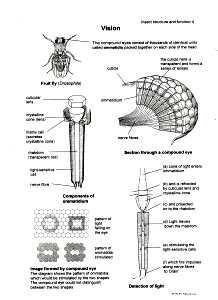NEW BOOK! HOT OFF THE PRESS!!
“HOW DOES INSTINCT EVOLVE”
OR
Evolution's Soft Underbelly
by Asyncritus
AT LAST!
The Argument Darwin Dreaded…
The Argument No-One Has Developed Before…
The Argument to Which There Is
NO ANSWER FROM THE EVOLUTIONISTS!
45,000 viewers of my articles can’t all be wrong. Check Google for this subject and see!
http://www.thenakedscientists.com/forum/index.php?board=17.30
140 pages of amazing facts and carefully reasoned arguments. Equip yourself! Give your children the knowledge to defend belief in Creation in class!
Get your copy here. Only £4.97 as pdf.

THE EYE OF THE TRILOBITE
A Miracle of Creation
http://shkrobius.googlepages.com/wondersofnature

A beautiful drawing can be seen above. The link is here, where it can be viewed at a larger size: http://www.biology-resources.com/insects-02.html
Let’s first get acquainted with a compound eye. Instead of the single eye such as we have, each compound eye consists of a thousand or so individual ‘eyes’ called ommatidia.
Each ommatidium is made up of a lens (more about this later), a crystalline cone under it, and a nerve cell which conducts the electrical impulse to the creature’s brain where it is interpreted.
Around each cone (corresponding to the biscuit of an ice cream cone) is a layer of light absorbing material, which prevents the light in each cone being scattered and degrading the image created by other ommatidia.
All arthropods have this type of eye.
The trilobite’s eye, consisting of millions of honeycomb-shaped tiny particles and a double-lens system, this eye "has an optimal design which would require a well-trained and imaginative optical engineer to develop today". David Raup
”Moreover, the honeycomb eye structure of the trilobite has survived to our own day without a single change. Some insects such as bees and dragon flies have the same eye structure as did the trilobite.”
So, to put it plainly, the design of the trilobite’s eye was so advanced that it exists today, virtually unchanged. That unchanging structure is direct testimony that evolution has not taken place: certainly not in this structure.
I used the word ‘design’ because it clearly meets the criteria for deciding whether or not something was designed: it is a complex structure, it has a specific function, and it employs advanced information in its construction. To reiterate:
1 It is a very complex structure, not a simple one that may have just happened.
2 It has a specific function, which it fulfils well – and we know that because the eye has persisted unchanged for millions of years.
3 It makes use of information – which blind mutations cannot do. The high quality of the information is shown below.
The lens system refracted light incident from any angle into the trilobite vision system. A small wall to keep refracted light from interfering also partitioned the separate lenses. This is a feature of modern cameras: there is a light absorbing layer (usually black) inside the camera’s film chamber – to absorb stray light and prevent it degrading the image.
This is clear evidence of specificity of the design. The Designer knew about light scattering, and specifically prevented it. He knew about lenses, their required curvature, and the aberrations that such lenses produced. And as a direct, required consequence, produced the next invention:
‘The thick lenses in the aggregate eyes of a group of trilobites were doublet structures designed to eliminate spherical aberration.’ http://www.nature.com/nature/journal/v254/n5502/abs/254663a0.html
Nature 254, 663 - 667 (24 April 1975); doi:10.1038/254663a0
“The thick lenses in the aggregate eyes of a group of trilobites were doublet structures designed to eliminate spherical aberration. The shape of the optically correcting interface is in accord with constructions by Des Cartes and Huygens and is dictated by a fundamental law of physics. Trilobites may have evolved such sophisticated eye-lenses to maximise optic neurone response in a dimly lit environment.”
This is even clearer use of information, proving conclusively that design is present. The Designer knew about correcting spherical aberration by using doublets possessing different refractive indices. He was way ahead of DesCartes and Huygens, and knew about the fundamental law of physics governing such correction.
He also knew about amplifying dim light – presumably as Night Vision Goggles are intended to do today, as the authors above said: “…such sophisticated eye-lenses to maximise optic neurone response in a dimly lit environment.”
Here is another article describing the same phenomenon.
“This eye possessed an internal optical-doublet structure together with a refracting interface (comprised of two lenses with differing refraction so they would work together) that corrected focusing - a lens design that human scientists would repeat hundreds of millions of years later.” (In fact courses on optical DESIGN are offered which teach about optical doublets, inter alia). Here if you want to attend one: http://www.imperial.ac.uk/research/optics/msc/syllabus.htm
In case you don’t know, spherical aberration is the blurring of an image that occurs when light from the margin of a lens or mirror with a spherical surface comes to a shorter focus than light from the central portion. The changing focal length is caused by deviations in the lens or mirror surface from a true sphere.
‘The novel eyes of the trilobites were a particularly effective adaptation to underwater sight, and were ostensibly plagued by neither near-sightedness nor far-sightedness. Close and distant food and predators would be simultaneously in focus.’
This is a feature of modern wide-angle lenses: which are among the most advanced in the world. And here it is in the eye of a humble trilobite, millions of years ago.
Evolution is helpless to produce such a structure. A Designer, on the other hand, could do it with ease.
No comments:
Post a Comment